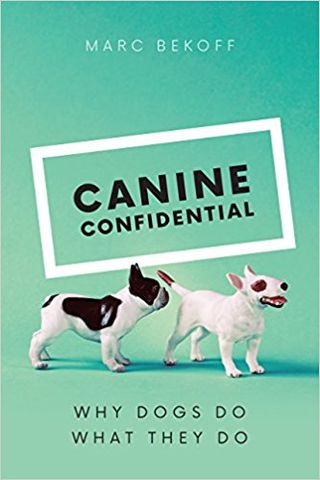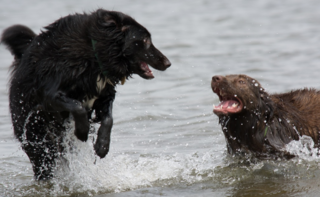Play
Canine Confidential: Why Dogs Do What They Do
A discussion of how dogs sense the world, play, dominance, peeing, and emotions
Posted April 11, 2018
For all the love and attention we give dogs, much of what they do remains mysterious. Just think about different behaviors you see at a dog park: We have a good understanding of what it means when dogs wag their tails—but what about when they sniff and roll on a stinky spot? Why do they play tug-of-war with one dog, while showing their bellies to another? Why are some dogs shy, while others are bold? What goes on in dogs’ heads and hearts—and how much can we know and understand?

Canine Confidential: Why Dogs Do What They Do has the answers. Below is an interview I did with Dr. Zazie Todd for Companion Animal Psychology about this book.
Dr. Todd: Why did you decide to write Canine Confidential?
There are many reasons, and in reality, I've been writing this book for many, many years. I bring a unique perspective to the study of dogs in that I was trained in ethology and have done long-term field work on free-ranging dogs, wild coyotes, and various birds including Adélie penguins in Antarctica.
Among the most important reasons are: to emphasize how important it is to watch dogs and to learn as much as one can about different aspects of behavior; to emphasize that there is a good deal of individual variability among dogs so speaking about "the dog" is misleading; to stress that dogs display multiple intelligences and don't only "live in the present"; to show that dogs are not dumb-downed wolves; to provide a lot of detailed data in accessible prose to non-researchers, information that can be used to allow dogs to be dogs as much as they can be in an increasingly human-dominated world (in many ways, dogs are captive animals whose freedoms are severely restricted); to discuss how dogs sense their world via smell, sight, hearing, touch, and taste, and why they should be allowed to exercise their senses and to sniff to their hearts' delight; to let their walks be for them, not for us; to dispel myths such as dogs are unconditional lovers (anyone who's rescued a dog who has been abused knows this to be so), peeing and marking are the same, growling is always aggressive, it's a bad idea to hug dogs or to play tug-of-war or to "get down and dirty" and to romp around with them (when we do it must be on their terms, of course; also see), that dogs (and other nonhuman animals) don't display dominance (they do, but we shouldn't dominate them to get them to live in harmony with us), that they always circle before the lie down, that intense play-fighting always or usually escalates into fighting (research shows this actually only very rarely occurs); that dog parks are a bad idea across the board (they're not, but only dogs who like going to dog parks should be taken there); to provide trainers with information that can be used to enhance the dog's life when they work with their clients, canine and human, and to strongly suggest that trainers observe dogs outside of the context in which there is an issue; to strongly suggest that people select certified trainers and to choose someone as carefully as they'd choose a neurosurgeon; and to stress how important it is to allow dogs to exercise their senses, their muscles, and their hearts.

I mix in a good deal of the latest research on various aspects of dog behavior with numerous stories, and take a descriptive "anatomical" approach to naming the dogs with whom I've had the pleasure of meeting and watching. For example, readers will meet Bernie and Beatrice "the butt-ers," Tammy "the tongue," Louie "the licker," Harry and Helen "the happy jumpers," and Peter "the pecker-pecker." All names, canine and human, have been changed to protect the guilty.
I also write some about human-human interactions and how they reveal a lot about their dogs and the people themselves. It's just a coincidence that this is The Year of the Dog, and I'm thrilled that my book was published in this special time. Of course, every day should be "the day of the dog" because we are so fortunate to have them in our lives. They should only be as fortunate to have us in their lives.
The subtitle of the book is Why Dogs Do What They Do, and in it you answer lots of questions about why dogs do things, like ‘what are they doing when scent marking?’ and ‘why do they roll in stuff?’ How did you pick the questions, and are there any of the topics that are particular favorites?
I selected the different topics based on many decades of studying dogs and their wild relatives, by cataloguing questions that I've been repeatedly asked when talking with people at different venues, and also by paying attention to those areas that are important to understand to give dogs the very best lives possible. Among my favorites are play behavior -- how dogs are able to play fairly and have fun-on-the-run as they engage in frenetic "zoomies" and low-key play -- and topics centering on the cognitive, emotional, and moral lives of dogs and other animals. I also really enjoy listening to people talk about their dogs and also other people at the dog park and their friends. Dogs can be social catalysts for bringing people together and really get people talking about things they don't typically share out of the places where they bring their dogs for exercise and to have fun with other dogs. Sometimes I'd politely excuse myself when someone was sharing TMI (too much information).
You write a lot about the emotional lives of dogs. How do we know which emotions dogs experience – and what more do we need to know?
That's a great question. There are ample detailed data from many ethological perspectives and a growing number of neuroimaging studies that clearly show that dogs are emotional beings who experience joy, happiness, sadness, grief, pain, disgust, jealousy, and likely guilt. The bibliography and the notes in Canine Confidential are lengthy and filled with up-to-date data from ethological and neurobiological studies. These data clearly show that the real question at hand is why emotions have evolved, not if they have evolved. The reason I write that it's likely dogs display guilt is because we really don't know if this is the case quite yet. An oft-repeated error in both scientific essays and the popular press goes something like, "Research has shown that dogs don't display guilt," and a study by Dr. Alexandra Horowitz is cited as evidence. However, she did not show that dogs do not display guilt, only that we are not very good at reading guilt in dogs. I include an exchange with Dr. Horowitz about this point, with which she totally agrees. She wrote, "My study was decidedly NOT about whether dogs 'feel guilt' or not." Readers will be pleased and surprised to see how much we really know about the emotional lives of dogs, and I also point out where more research is needed. One can be sure that dogs are sentient beings who care about what happens to themselves, their families, and their friends.
The book is full of lovely stories about dogs, including your own dogs. As a writer, do you most enjoy writing about the scientific research or about the anecdotes, or do you prefer writing about both together?
I really prefer writing about both together, as I do in my book and in numerous essays that I write for Psychology Today about dogs and many other animals. It's always interested me that many anecdotes are supported by empirical data that are collected at a later date. I also write a good deal about the importance of "citizen science," and that's why I encourage people to become ethologists and "naturalists in the dog park" if they go there with their dog(s).
One thing that’s clear from this book is that people tell you stories about their dogs at the dog park, or email you stories about their animals. Are there any particular topics that people tend to talk to you about the most?
Not really. What I love about the stories I'm told is how wide-ranging they are. Quite often, the questions I'm asked and the stories I'm told focus on a particular dog and their human, and the unique relationship they've formed. Once again, there not only is a good deal of within species variability among dogs, but also among their humans and in the dog-human relationships that are formed. I feel very lucky to have people share their stories with me in person and via email and the occasional letter, although sometimes when I open my email inbox I feel overwhelmed. But, that feeling disappears rapidly as I learn more and more about dogs and their humans.
You say that even though we don’t know everything about dogs, we still know enough to be able to give them rewarding lives. What are the most important things we can do for our dogs?
Love them, respect them, meet them at least half-way, develop mutual tolerance, and learn as much as you can not only about dog behavior but about the unique individual(s) with whom you chose to share your home and your heart. And, let them be dogs as much as possible. There's no reason to be helicopter guardians, yet people say "No" or "Stop that" far more often than they say "Good dog" or "That's ok." In some ways, my books can be viewed as a field guide to freedom in which I encourage people to unleash their dog as much as possible. Choosing to live with a dog (or other animal) is a "cradle to grave" commitment and we must remember that we are their lifelines.
At the end of the book, there is a really nice appendix that teaches people what ethology is and how to do it. What can people gain from becoming ‘citizen ethologists’?
They can gain a lot. By becoming fluent in dog they not only can learn some nitty-gritty details about dog behavior, but also about how unique each dog is. It's also a lot of fun to do these informal studies, and I love it when people come to me and ask me how to become an ethologist. In the book I tell stories about how people have told me that learning to "speak dog" and to try to think like they do has helped them not only to understand their dog, but also how this information improves their relationship with their canine companion. Learning about dog behavior and dog-human relationships is a win-win for all.
Canine Confidential: Why Dogs Do What They Do is published by Chicago University Press.




